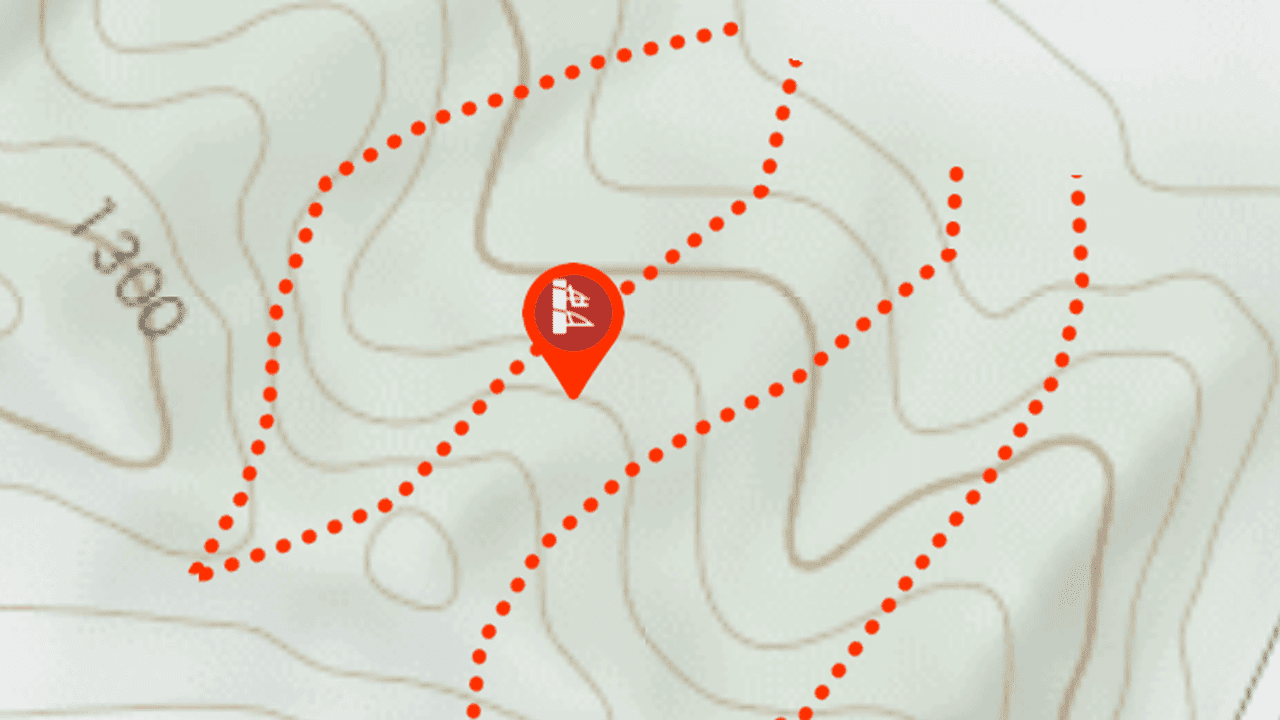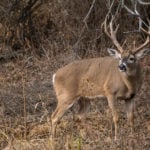Our friends at onX continue to share their wealth of wisdom on how to utilize their app to get you closer to the game. The following series on How to Hunt Whitetail Deer with the onX Hunt app will reveal a variety of secrets and insights to help you narrow down your search and be more successful on your next whitetail deer hunt. In part 1 of this series, we’ll focus on food plots, entrance/exit strategies, treestand placement, trail camera use, and using funnels to your advantage.
Food Plots, Entrance / Exit Strategies and Tree Stand Placement
The onX building in Missoula, Montana, is filled with passionate hunters from a variety of backgrounds. Whether we’re out chasing spring turkey, spending our summers in the backcountry setting trail cameras, sighting in rifles at the range or hiking tents into backwoods drop sites in anticipation of the season, we are always comparing, contrasting and seeking the best ways to chase game.
In this two-part series, we’ll be sharing our top tips for hunters using the onX Hunt App in their pursuit of whitetail. From food plots and stand location to getting landowner permission and access easements, we’ll help you make the most of your season.
Food Plots
When planning a food plot for hunting, ensure your plot is not going to be visible from any public roads—don’t invite the competition. Look for areas of safety, ideally with direct routes of travel to and from the whitetails’ bedding areas. Before planting your plot consider picking out trees you could hunt from, intercepting deer on their way in or out of the area (as well as on the plot), bearing in mind predominant wind direction.
Wondering how much seed to buy? Use onX’s Shape Tool to determine the acreage of your plot. It’s also worth considering the prospect of planting long-term food plots, such as a stand of apple, pear, plum or persimmon trees. Though these will take years to develop once planted, there’s not much work involved other than ensuring the survival of the saplings, and the trees will provide food for years to come.
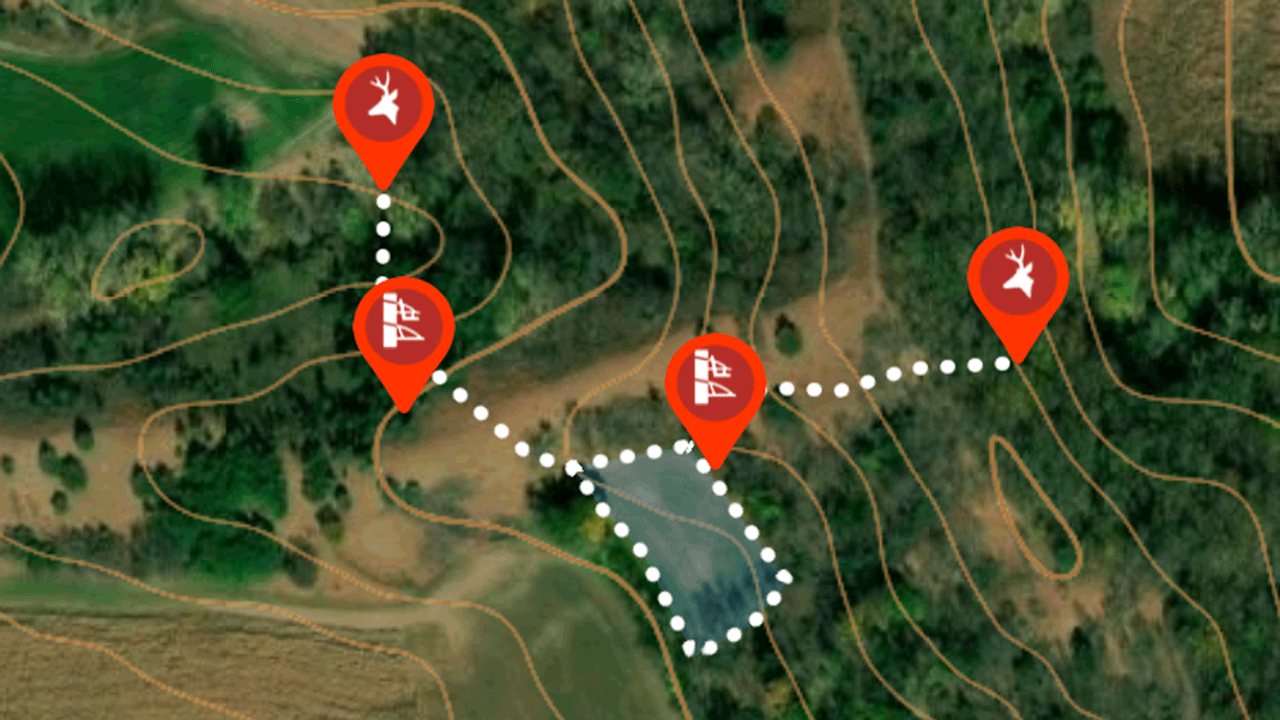
Treestand placement is the name of the game when it comes to scoring on whitetail deer.
As you can see with this potential plot, it is a small (.56 acres if you query the shape) well-protected food plot more than a quarter mile from the nearest road with elevation to block the view. It’s also within a tenth of a mile of two well-used bedding areas, making it an ideal food source with both cover and proximity to bedding.
The potential plot is surrounded by cover on its eastern and southern borders, a fence line on the western and a ridge overlooking it to the north. This allows deer a sense of safety with the ability to scan the plot before arriving as well as multiple direct exit points into cover. This particular area sees a north/northeast prevailing wind in fall, allowing for two perfect setups. The two bedding areas are on higher elevations and in cover, allowing big bucks to survey surrounding areas before hunkering down.
Placing the stand to the west allows you to come in undetected from the below field edge for an evening sit. From there you are not only able to cover the trail coming from the bedding area to the north, but also to oversee the entire field below to observe where deer are filtering in and out.
Placing the stand on the plot allows you to hunt deer coming from the bedding area to the east as they walk the ridge with the ability to scan the food plot, and then hopefully follow the most well used trail into the corner of the plot. Often corners are the most common entry points of food plots, so consider having plots fairly small in size to ensure the ability to make ethical shots with archery equipment to the majority of the plot.
Setting Trail Cameras
Any hunter who places multiple trail cameras appreciates the ability to mark trail camera locations. Set your cameras before spring turkey season, get the birds patterned and then after tagging out move them to areas where you can catch photos of velvet growth. Many of our onX staff deploy nearly a dozen cameras, and the ability to reference a Waypoint to see where you placed a trail cam can be very helpful come September when you aren’t entirely sure where you put a couple of your experimental cameras.
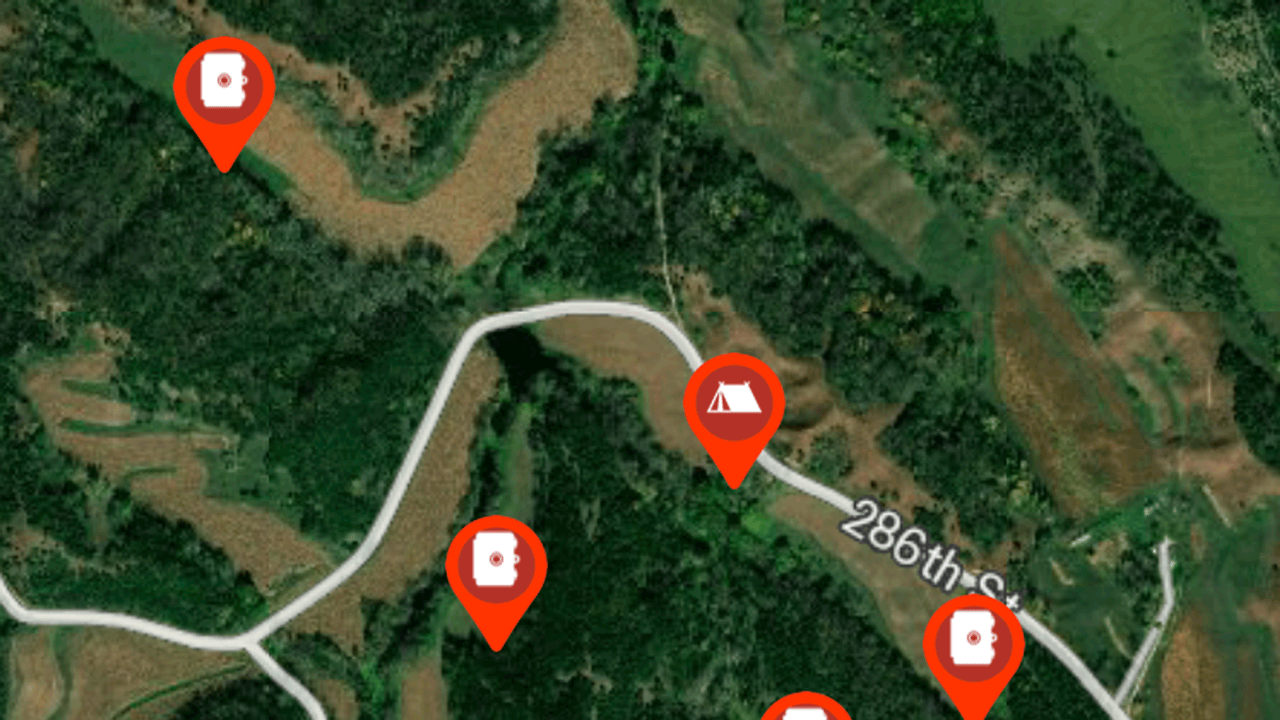
Making notes on your trail cam placement is a handy way to keep track of where you’ve placed your gear later in the year.
As you organize your photos by camera, you can then sort through the different deer you have photographed. Then, from this aerial image, you can see which deer you have at each camera site, giving you insight on what each particular buck’s travel patterns are. As this changes from summer to fall and eventually to the rut, you can begin to pattern a deer not only from this year’s photos, but from years past to truly get an understanding of where he is going to be and when.
Locating Natural Funnels
Natural (or even unnatural) funnels can exist in a variety of forms. In this instance there is a gate that connects two fields, a creek crossing, multiple fence lines and a ridge that all funnel deer to the hub of the “wheel.”
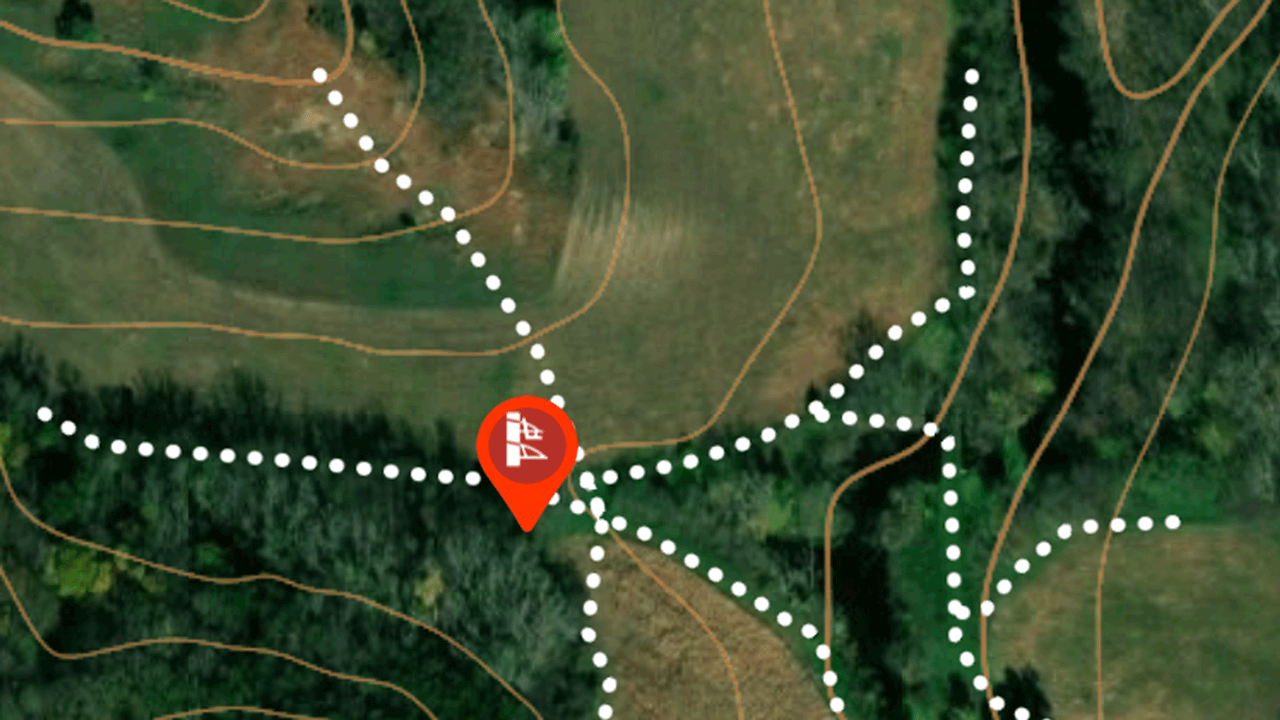
Watch for “hub” locations that are central travel points for deer transitioning through the property.
With the tree stand positioned as shown, it puts the hunter in the best possible spot to have a chance at a deer transitioning from one area to the next.
Due west of the stand is a field edge that runs along a fence line with dense cover leading up a ridge. Many times deer will hit the field edge from their bedding cover and work down toward the stand location.
To the north is a ridge, allowing deer to survey what else is in the fields below, offering a great opportunity to use a decoy paired with rattling and grunts to bring in a dominant buck.
To the east offers a field edge that leads to man-made creek crossing at the 90-degree turn. This is the only creek crossing on that piece of water, often leading deer right to the hub of the wheel that this particular stand overlooks.
onX’s aerial imagery can be used to determine areas such as this, where you will find locations intersecting many different routes of travel. You can also use our improved topo maps to help determine funnels connecting multiple food sources and/or bedding locations; areas mature bucks will likely cruise during the rut.
Here is the same area with the aerial imagery and topo turned on, our hybrid basemap.
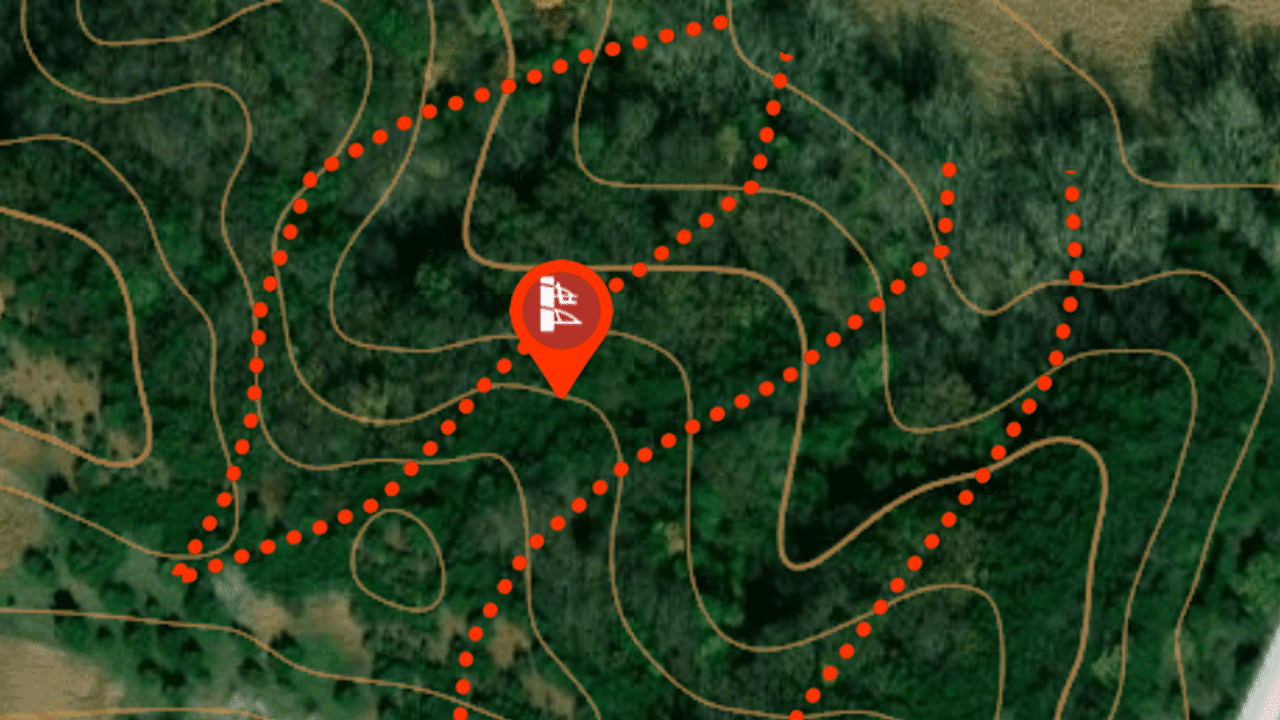
If you’re a fan of tech tools for getting you closer to the game you pursue, you’ll love part 1 of How to Hunt Whitetail Deer Using the onX Hunt App.
The tree stand is placed on the spine of the ridge in the middle of the two gulleys that funnel mature deer checking does and cruising between feed sources. Though travel through these areas is often not super consistent, it places hunters in “the zone” and with a set of good 8x binos, rattling antlers and a grunt tube, this has been an area onX staff has killed many mature bucks mid-morning as they were cruising for hot does.
Treestand Locations
Treestand location is a topic on which everyone has their own strategies, but there are a few universal factors to consider when hanging stands.
Likely the most popular and obvious of stand locations is sitting food. Whether that is the edge of a crop field, over a food plot or finding a stand of oaks dropping acorns, sitting over the grocery store will produce action-packed evenings as the season rolls into the rut. Crop field edges are one of the best places to sit pre-rut to take inventory on where deer are filtering in and out of fields, what deer are around and how close the rut is based on deer interaction. Often these stand sites offer high visibility and sometimes are strategically placed to simply be a stand to watch from, not necessarily a killing tree (but they certainly can be in the right situation).
Water, obviously, is a key requirement of any animal. The challenging aspect of water is that in many locations deer get enough water through the food they eat, and by the time bow season rolls around the dog days of summer are a thing of the past. That said, hot days late in the season, drought years and strategically-placed water during the rut can lead to a full freezer.
Cover (specifically bedding cover) is some of the most sought-after knowledge in the whitetail woods. No different than you or I, deer often sleep in the same areas day after day. If you can find where a mature buck sleeps the other pieces of the puzzle can fall into place quickly. That said, these sits are a high-risk strategy. Bump a mature buck from his bedroom and you may never see him again, but get to your treestand undetected and it may be a sit you never forget.
Seclusion is also a significant factor to consider, especially when hunting pressured public lands. Mature bucks will not put up with consistent human traffic. If you can find the thickest, deepest, gnarliest part of the property you are hunting, you may not see a lot of deer, but the ones you do see will be worth the wait.
Another significant factor in which tree you can or cannot sit is prevailing winds. Though not perfectly predictable, most locations have seasonally consistent winds. Pick your trees with this information in mind.
The tree you pick is arguably the most important factor in your success. All too often a great area can be found with less-than-ideal trees. Background is key when picking the right tree. Try to foresee that same tree leafless in November when hanging your stand in July or August is critical. In the summer every tree looks like you can do jumping jacks in it without being seen, but by November there are very few single trees that you can get away with drawing back on a mature buck in.
When sitting deciduous trees, either a large tree, split trees or small clusters of trees seem to provide the best remedy for not becoming a silhouette against the sky. If possible, coniferous trees are optimal. These trees provide tons of background, lots of scent to rub on yourself to help cover odor and wind protection to keep warm. Be careful over trimming—be as conservative as possible when cutting shooting lanes. Obviously you need to be able to get off a clean, ethical shot, but over trimming shooting lanes becomes very obvious to wary whitetails.
Pinch points, whether natural or man-made, make great stand locations. Pinch points can include the narrowest point of a gully where two ridges funnel activity, a gate in a fence or even a small isthmus of land. Deer are often funneled through these areas when transitioning from food to bedding. These points can make great ambush stands, especially as a mid-season set after you have seen a mature buck cruise through the area.
Bear in mind the first time you sit a stand should be your best sit, and best chance to touch off the trigger. Your scent has not been present before, you’ve never been spotted in this tree and this should be a recipe for success. Never be hesitant to hang a stand after seeing movement through a particular area at any point in the season. Going in midday, hanging a stand to sit that evening or the next morning can be a highly successful strategy.
Treestand Entrance / Exit Strategies
How to effectively enter and exit stands is an often-overlooked piece of the whitetail puzzle. The treestand shown below is a prime example. The doe waypoints represent known bedding areas in thick cover on the spine of a ridge. Many times walking the field edge when entering the stand in the morning and leaving in the evening is certain to blow deer out of the agricultural fields when feeding. During the summer months, consider clearing multiple trails into your stand so you can walk in based upon deer feeding habits, wind direction and time of day.
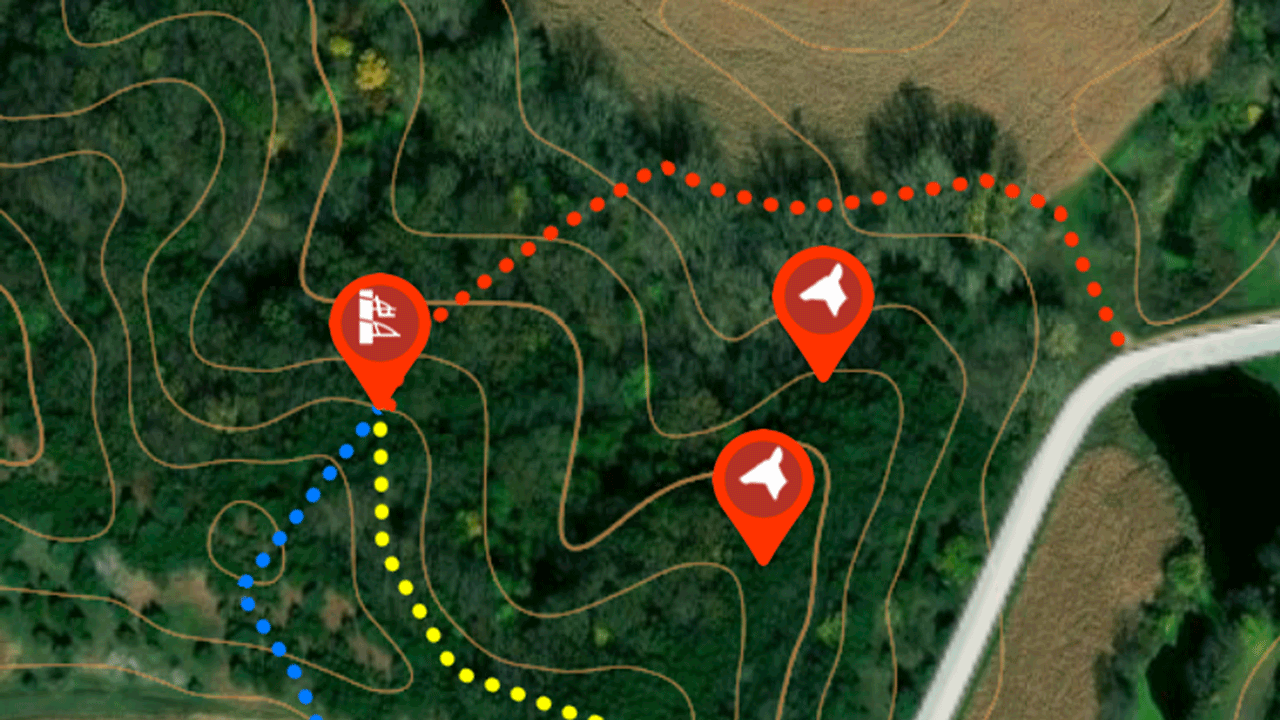
A lot of hunters fail to consider their treestand approach. Don’t let this be you.
The red line is the certainly the easiest way in with the least incline and resistance, but with prevailing northerly winds in the fall it will blow your scent right into the bedding areas. You would also blow feeding deer out of the agricultural areas when entering in the morning and leaving in the evening.
The blue line would be the second most obvious point of entry, but the same issue of blowing deer out of the ag fields is still present.
This means it’s incumbent on the hunter to undertake a bit of summer prep work to make the yellow line entry point the best option. All it takes is a rake and snippers to clear a small trail to sneak into tree stands. With the yellow trail, you do not expose yourself on the field edges, you are downwind of the bedding areas and you can get to your treestand undetected. It is inevitable that deer utilize a cleared trail, but that is simply part of the game.
Stay tuned for “How to Use the onX Hunt App to Hunt Whitetails Part 2: Getting Permission, Tree Stands and Deer Drives”—coming soon!

